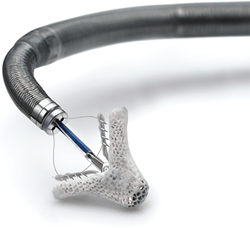The need for structural repairs of the heart can be due to congenital deformities or the progression of cardiac disease. These structural problems can be repaired during open-heart procedures requiring cardiopulmonary bypass, using minimally invasive surgical approaches (off-pump) or transcatheter delivery systems.

Annuloplasty devices: Annuloplasty devices are used to reduce valve regurgitation by pulling the leaflets together to reduce undesired backflow. Annuloplasty rings can be directly placed on the valve annulus. Direct annuloplasty is typically performed via open-heart surgery to access the valve. Indirect annuloplasty involving a device in the coronary sinus has been investigated to reduce mitral regurgitation. However, there is a risk of compromising blood flow of the nearby circumflex artery.

Edge to Edge Procedure: The Edge to Edge Procedure is a technique used to treat mitral regurgitation. The leaflets of the mitral valve are stitched together to create two smaller openings to reduce backflow. New products, such as the MitraClip, can deliver this technique through a transcatheter approach.
(figure from www.abbottvascular.com)
Coronary Bypass: Coronary Bypass is a surgical method used to treat coronary artery disease. When a coronary artery is narrowed or obstructed, a vessel (typically from elsewhere in the patients) can be used to bypass the narrowed artery. One end of the vessel is typically attached to the aortic root or left subclavian artery. The other end is attached distal to the narrowed portion of the artery so that oxygenated blood can reach that part of the myocardium, hence the occluded coronary region is bypassed.

Septal Closure Devices: Atrial or ventricular septal defects are congenital deficiencies in the heart walls separating systemic and pulmonary circulations within the heart. In the case of an atrial defect, blood from the lungs flows through the defect and increases the volume of blood passing through the pulmonary arteries. For individuals living with such defects, permanent damage to pulmonary vasculatures can eventually occur. Cardiac surgical procedures or transcatheter delivered technologies (septal closure devices) can be employed to close these septal defects.
La necesidad de reparar defectos estructurales cardíacos puede deberse a deformidades congénitas o a la progresión de una enfermedad cardíaca. Estos problemas estructurales pueden repararse a través de cirugías a corazón abierto que requieren bypass cardiopulmonar, utilizando cirugía mínimamente invasiva (sin bomba) o sistemas transcatéter.

Dispositivos de anuloplastia: los dispositivos de anuloplastia se utilizan para reducir la regurgitación valvular al aproximar las valvas para reducir el reflujo no deseado. Los anillos de anuloplastia se pueden colocar directamente en el anillo de la válvula. La anuloplastia directa se realiza mediante cirugía a corazón abierto para acceder a la válvula. Se ha explorado la anuloplastia indirecta a través del seno coronario para reducir la regurgitación mitral. Sin embargo, existe el riesgo de comprometer el flujo sanguíneo de la arteria circunfleja.

Procedimiento de borde a borde: el procedimiento de borde a borde es una técnica que se utiliza para tratar la regurgitación mitral. Se suturan las valvas de la válvula mitral para crear dos aberturas más pequeñas y reducir la regurgitación. Los nuevos productos, como MitraClip, pueden ofrecer esta técnica a través de abordaje transcatéter. (figura de www.abbottvascular.com)
Coronary Bypass: es un método quirúrgico que se utiliza para tratar la enfermedad coronaria. Cuando una arteria coronaria se obstruye, se puede utilizar un vaso (de otra parte del cuerpo) para desviar el flujo de sangre de la arteria ocluida. Un extremo del vaso suele estar unido a la raíz aórtica o la arteria subclavia izquierda. El otro extremo está unido distalmente a la porción distal de la lesión en la arteria coronaria para que la sangre oxigenada pueda llegar a esa parte del miocardio.

Dispositivos de cierre de defectos septales: los defectos del septo auricular o ventricular son patologías que comprometen las paredes del corazón que separan la circulación sistémica y pulmonar dentro del corazón. Se pueden emplear procedimientos quirúrgicos o dispositivos administrados con abordaje transcatéter para cerrar los defectos.


